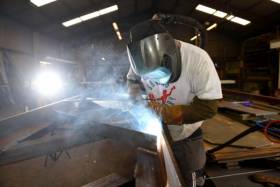Displaying items by tag: Restoration Project
A restoration project of the iconic turbine steamer, TS Queen Mary at Govan Graving Docks is set to generate new jobs on the Clyde.
The TS Queen Mary on Friday was moved from its current berth at Glasgow Science Centre to Govan Graving Docks, the first ship to be berthed at this historic facility in almost 40 years.
Marine Projects Scotland Ltd has been awarded the contract to project manage and undertake the first phase of major restoration and repair work on the TS Queen Mary.
The year-long project will help preserve the iconic ship and will also create much-needed employment opportunities for up to 12 people, bringing associated community benefits to the Govan area.
The scope of the restoration work will be extensive and structurally complex, starting with a 3D laser map scan of the ship’s structure, prior to the removal of the two funnels and wheelhouse, which will be completely rebuilt.
The ship will be encapsulated for the removal of the windows and teak boat and promenade decks, which will receive underdeck stiffening, before being replaced with completely new steel decks, all of which is necessary to bring the steamer back into active service.
All of this work will meet Classification Society (Bureau Veritas) and MCA regulations, ensuring that the ship, upon completion, will be able to return to active service.
Peter Breslin, Managing Director of Marine Projects Scotland Ltd said: “It is a tremendous honour to be awarded the TS Queen Mary restoration contract. In the coming year, we will devote ourselves tirelessly to safeguarding, protecting and reviving this exquisite and historically significant vessel.
“Securing this contract is testament to our commitment and confidence in the business viability of Govan Drydock. As a fully operational ship repair and maintenance facility, it has the capacity to generate employment opportunities and contribution to the ongoing reinvigoration of the Clyde waterfront.”
Iain Sim, Chairman of Friends of TS Queen Mary, added: “The Trustees are delighted that this major contract will commence in TS Queen Mary’s 90th anniversary year. It will be truly transformative for this vital part of our maritime heritage. This major structural work will help breathe new life into TS Queen Mary and ensure she will be in the best possible condition for years to come.”
Harry O’Donnell, Chairman, New City Vision who own the site, said: “We are delighted that such a historic ship as the TS Queen Mary will be restored at our site in Govan. It is testament to the hard work that Marine Projects Scotland Ltd has done to date on Dock No1 that it is now in a position to be brought back into working order for the first time in more than 40 years.
“The restoration of Dock No1 is an important part of our wider vision to bring the Govan Graving Docks back into use, alongside the creation of new homes, commercial use and thriving new community spaces including a new riverside park and active travel routes through the site, all of which are currently undergoing extensive consultation.”
In her heyday, the Dumbarton-built ship, launched in 1933, once carried King George VI, Queen Elizabeth (the Queen Mother) and Mrs Eleanor Roosevelt, and was known as Britain’s finest pleasure steamer. During World War II, she became a vital lifeline for Scotland’s island communities, carrying around 13,000 passengers each week.
Queen Mary has been out of service for 35 years. The Charity “Friends of TS Queen Mary” brought her back to the Clyde in 2016. Since then, she has been berthed at Pacific Quay, next to the Science Centre.
In 1996, Queen Mary was listed on the UK’s official historical ships register and is now the last of her kind in the world.
Restored Mirror Dinghy Finds Its Home in Lough Erne Yacht Club
Upon Reflection is an appropriate name for another resurrected Mirror dinghy which has found a new home at Lough Erne Yacht Club.
It’s not often boats are the subject of an exchange deal, but that is what happened when Paul de Fleury got his hands on a very old Mirror dinghy, for which Lough Erne YC gifted a GP 14, and it is now sailing on Upper Lough Erne.
It seems it is a couple of years older than the other Mirror restored by Brian Osborne and now sailing on Lough Erne. This one, sail number 29429 and apparently built in 1971 was at Newtownards Sailing Club, and as NSC is a GP14 stronghold, it seemed sensible to exchange it for a surplus Lough Erne YC GP 14.
No.29429 was fully refurbished by Mark and Paul de Fleury in their garage in Carrickfergus and apparently, it took longer than had been hoped owing to the Covid outbreak. And although the hull, mast and spars were in a reasonable state for its age, it did need new sails.
Michael Brines of Lough Erne Yacht Club tells me the Mirror is owned by the club and is regularly used for training in Goblusk Bay on the eastern shore of the Lower Lough. Michael’s son Peter and daughter Emma are hoping to compete in Upon Reflection at the Mirror Worlds in Sligo in July next year.
Forging A New Future for An Isle of Man Old Iron Lady
#IslandNews - On the Isle of Man, sparks fly as a new future for Ramsey Pier is forged.
Fabrication of five replacement lattice trusses writes IOMToday, will support the decking of the Victorian landmark’s first bay is under way at the Gallas Foundry in Douglas.
They will replace the corroded wrought iron girders are to be removed by volunteers of the Queen’s Pier Restoration Trust.
It is hoped that the new steelwork can be installed before winter weather stops work.
In total, the Gallas Foundry is currently handling 19 tonnes of carbon steelwork for the pier.
For more on the pier's restoration (click here) which neighbours the small commercial port of Ramsey Harbour.





























































